Header logo
header top contact widget
Tooth Loss
Know How Oral Bacteria Form & Cause Damage
Posted on Nov 07, 2023 by William J. Claiborne, DDS MS
Often, once people understand how something breaks down, they are able to watch for telltale signs or take preventive measures. For example, when the grooves in a vehicle’s tires become more shallow, it’s obvious they need to make arrangements for new tires.
This is true, also, for your oral health. Knowing concerning oral signs and symptoms can help you prevent cavities, periodontal (gum) disease and tooth loss.
Oral bacteria exists in every mouth; some of it is “good” bacteria. The good bacteria are even helpful to the digestive system. However, harmful bacteria can run rampant if not kept under control.
The average mouth houses around 20 billion (that’s billion with a “b”), consisting of about 700 different types. Bacteria breed very quickly. The numbers can grow amazingly fast and their buildup produces a bacterial film that coats the teeth and gums. This is known as plaque.
Plaque is the sticky coating in your mouth, most obvious when you first wake up. When plaque is not removed regularly (through thorough brushing), the bacteria attack tooth enamel. Results include bad breath, yellowed teeth, cavities and tender gums.
Plaque formation actually begins as you chew carbohydrates, which seems to be prevalent in most of the foods we eat in today’s diet. As carbohydrates blend with saliva and existing bacteria in the mouth, an acid is created.
Plaque that is allowed to remain on teeth for about 48 hours hardens. This is known as tartar, which is a mass of bacteria that forms between and at the base of teeth.
Once in this hardened form, removal can only occur with special tools used by your dentist or dental hygienist. This is what your hygienist is scraping off during cleanings. Without tartar being removed, it causes the gums to swell, feel tender and may bleed when brushing. This is typically the initial stage of gum disease, known as gingivitis.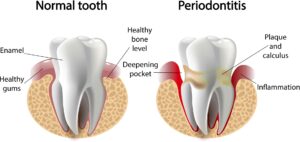
However, for people who brush twice a day and still have tartar formation between dental hygiene appointments, there are factors that may be contributing. Some of these are not common knowledge, which is important to know in your prevention goals. These include:
Having “dry mouth”: There are a number of reasons that some people suffer with a drier mouth than others. Unfortunately, those who have insufficient saliva flow (which continually helps to cleanse the mouth) are more susceptible to tooth decay from plaque and tartar.
Saliva protects teeth and gums by helping to manage the growth of harmful bacteria while maintaining a neutral pH in the mouth. This slows microbial growth and keeps bacteria from sticking to teeth.
Other contributors to dry mouth include aging, caffeine (including coffee, tea, sodas, and chocolate), smoking, and a wide range of medications (such as antidepressants, decongestants and diuretics).
Poor oral hygiene: Since the pandemic, normal routines have been uprooted for many people as they have adjusted their “ready for the day” tasks to more casual timetables. Unfortunately, this seems to have left the habitual brushing and flossing times to days where oral hygiene has dropped out of the twice-a-day routine.
A March 2023 poll (conducted on behalf of CeraVe) included 2,000 men between the ages of 18 – 42. They found that only 54% brush their teeth daily (with one-third admitting to only once a day when they do brush). To no surprise, a recent report by the Centers for Disease Control & Prevention reveals that nearly 26% of ages 20 – 44 have untreated dental caries.
Frequent snacking: Every time you eat or drink, an acid attack begins in the mouth. This acid flows in with saliva to begin the initial stage of digestion. However, this acid is very potent, enough to even soften tooth enamel. So, every time you take a bite of a cookie, acid flows into the mouth and remains there for about 20-30 minutes. When the mouth endures frequent acid attacks from snacking between meals, the damage to precious tooth enamel will catch up to you in the form of cavities.
In addition to the harm that oral bacteria can cause teeth, the gum tissues – essentially the protective coating to the vital structures that support teeth – endure the rigors of bacterial overload. Eventually, this catches up to most people in the form of:
• Gingivitis – As the initial stage of gum disease, inflammation is triggered by plaque buildup at the gum line. When daily brushing and flossing fail to thoroughly remove plaque, toxins form that cause irritation to the gum tissues. Once symptoms emerge, they may include seeing blood in the sink when brushing or having sore, swollen gums.
• Periodontitis – As the disease advances, the bone structures and fibers that support teeth are damaged by the destruction of infectious oral bacteria. At this stage, pockets form below the gum line, filling with bacteria-laden plaque.
• Advanced Periodontitis – In the advanced stage of gum disease, fibers and bone supporting natural teeth are destroyed. This can cause teeth to shift or loosen, requiring aggressive treatment to prevent tooth loss. Eventually, some teeth may require removal.
Proactive measures NOW can help you avoid costly repairs to teeth, tooth replacement or the treatment process to rid periodontal disease. Start now with:
– Brush twice daily, floss every day and maintain regular dental check-ups. Thorough at-home oral care and regular dental check-ups can help you avoid problems from occurring in the first place.
– Delay brushing after eating or drinking. Wait 20-30 minutes to allow the acid attack in your mouth to subside. Remember, this acid can soften tooth enamel. The abrasiveness of a tooth brush or tooth paste can wear away precious tooth enamel.
– Swish with water. Enjoy a cup of coffee or glass of wine but try to alter these with a glass of water, allowing it to wash over teeth before swallowing. Or, swish with water.
– Eat sweets only with meals. Rather than forgo a sweet indulgence as a snack, enjoy your favorites as dessert following your meal since your mouth is already enduring an acid attack. This merely prolongs an acid attack rather than trigger a new one.
A healthy mouth is important for your overall health, as research has shown. We now know that the inflammatory bacteria of periodontal (gum) disease are able to enter the bloodstream through tears in weakened gum tissues. Numerous studies have found this bacteria can trigger harmful reactions.
For example, the bacteria can cause inflammation that sets into motion risks factors connected to arthritis and diabetes. Some cancers have also been correlated to this bacteria. Heart disease, stroke and high blood pressure have been as well. Alzheimer’s is also being studied along these lines.
While there is no clear pathway to verify gum disease bacteria are the “cause” of these serious conditions, research has continually shown they are linked, which can greatly increase one’s potential for having these problems develop (or worsen).
If you haven’t been fully committed to your oral health, there is no better time to begin than the present. Start with a thorough periodontal examination by calling 828-274-9440.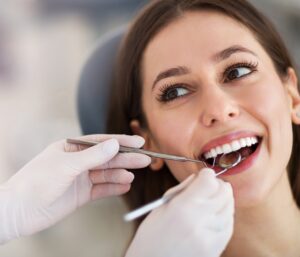
If dental fears have caused you to delay or avoid regular dental care, consider beginning with a consultation. This occurs in a comfortable, private room that is removed from the clinical side of the office. Too, many treatments can include oral or IV sedation (sleep dentistry, or “twilight sleep”).
And, if budget constraints are an obstacle, we offer several payment plans. Most are interest-free with no down payment required (for qualified individuals). Feel free to ask about these during your consultation.
Sources:
www.todaysrdh.com/
perio.org
Missing Teeth? HOW You Replace Them Will Make the Biggest Difference.
Posted on Oct 23, 2023 by William J. Claiborne, DDS MS
I remember a time when people assumed they would lose their natural teeth as they aged. Wearing full dentures in one’s senior years was almost an expectation. However, today’s adults are less accepting of “false teeth.”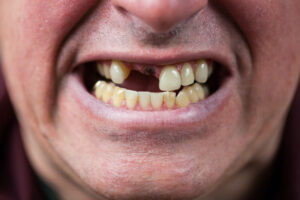
Over time, adults have learned that the removal of a natural tooth has lasting repercussions. Although the tooth may have been removed because of decay or a break, the long list of problems and associated expenses are generally far greater than what was anticipated. I’ll explain.
When a natural tooth is removed, its absence causes a reaction that begins below the gum line. Without the presence of tooth roots, the bone begins to “melt.” This process is known as resorption.
The absence of a tooth root in the upper or lower jaw bone removes stimulation to the bone mass where it was once positioned. Along with the stimulation, natural tooth roots channel nourishment needed for maintaining a healthy mass.
Resorption begins shortly after the tooth root is removed. Once it starts, it continues at an ever-increasing pace. For example, the first year after a tooth root is missing, the loss of bone may be minimal. With each passing year, the pace of loss accelerates. For people who sleep with their dentures, the 24/7 pressure on the gum ridge speeds up the pace even more.
As the bone shrinks in height, the natural tooth roots adjacent to the area of missing teeth are subject to movement and root damage. On average, the next teeth you’re most likely to lose are the ones bordering areas of missing teeth.
Obviously, it is important to replace lost teeth before bone loss begins. For the support of remaining natural teeth, it’s also important to replace missing teeth as soon as possible so adjacent teeth can retain their proper positions. Yet, merely replacing the presence of a tooth above the gum line leaves the underlying risk factors in place. Over time, problems arise for most individuals.
There are many reasons we recommend dental implants for tooth replacement, whether for one, several or a full mouth of missing teeth. Dental implants recreate stimulation to the jaw bone, thereby halting the pace of bone loss. When bone mass is maintained, neighboring teeth have a reduced risk for being lost as well.
Because dental implants are held in the jaw bone, they are able to restore a natural biting strength with dependable stability. Having the ability to bite and chew efficiently and enjoy a diet of foods you love enhances eating pleasure and proper digestion. It’s no surprise that people who wear dentures have more gastrointestinal problems than those who have their natural teeth.
Another advantage to dental implants is their longevity. When dental implants are properly selected, placed and maintained, they should last your lifetime. This is why it’s so important to have your implant treatment through a Periodontist.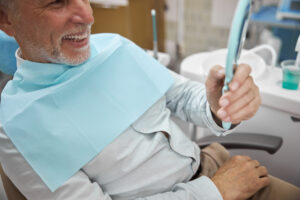
A periodontal specialist has advanced training to properly diagnose and place the most appropriate dental implant system for your needs and goals. As an Asheville periodontist with over 30 years of experience in dental implants, I have a reputation for treatment that provides the most successful outcome based on each patient’s unique needs – and by the most conservative means possible. Thus, the patient avoids having more time and expense involved than is necessary.
We are also known for providing a high level of patient comfort through the administration of IV sedation (twilight sleep) with our on-site Board Certified Anesthesiologist. Additionally, diagnosis and treatment planning is backed by images from our on-site 3D Cone Beam imaging.
Our Western NC periodontal office is fully prepared for the placement of dental implants. We tend to our patients in an efficient and effective manner so treatment occurs in minimal time and to an exceptional level of comfort.
We receive many patients who have been referred by their physician, dentist, and past/present patients, often because of our advanced skills and the respectful environment we provide. Here, each patient is treated with the same respect, compassion and gentle hands that we would want for ourselves and our loved ones. We take great pride in knowing our patients experience the finest periodontal and implant care in the Southeastern U.S.
A periodontist is a dental specialist who is trained to understand the intricate concepts involved in selecting the proper type of implant and skilled at placing implants at proper depths and angles. A periodontist is also able to optimize patient comfort during treatment and throughout the healing phase.
In addition to this advanced training, our office offers some of the most advanced technology available. This aids in the diagnosis and treatment planning of dental implants, providing patients with optimized comfort and outcomes. This technology, combined with our advanced skill level, creates a comfortable, efficient experience that helps you enjoy a lifetime of confident smiles.
Dental implants are also designed to last a lifetime. I can think of very few things that provide this kind of value. With proper selection and maintenance, they will never need replacing or repair, making them an excellent investment.
If you are considering dental implants, increase your potential for a successful outcome by asking a Periodontist to join your dentist in team treatment. Most general dentists have close relationships with periodontal specialists for implant placement, gum reshaping and in the treatment of gum disease.
If you have lost natural teeth or are facing the potential of tooth removal, call 828-274-9440 to schedule a consultation. This will occur in a private, comfortable consultation room conveniently located in our Asheville periodontal dental office. During this time, we’ll discuss the implant systems that may work best for your needs and preferences. I’ll explain the treatment involved, sedation options and estimated fees.
A “Lecture-Free” Look At Cigarettes & Your Smile
Posted on Oct 11, 2023 by William J. Claiborne, DDS MS
In this article, I’m going to address cigarette smoking as it affects oral health. This is not intended to lecture or chastise an adult for making a choice to smoke or those caught up in the addictive grip of nicotine. My goal is to relay factual information regarding oral health for smokers so they can better protect their smiles.
Because I’m a native North Carolinian, I’ll begin by sharing some information on our State, as provided by 2018 stats from the CDC (Centers for Disease Control & Prevention).
In 2018, the percentage of adults in North Carolina who smoked was reported as 17.4% (of every 100 adults). The CDC shared findings of all states, with smoking ranged from nearly 9 of every 100 adults in Utah (9.0%) to 25 of every 100 adults in West Virginia (25.2%).
They also shared that cigarette smoking was lowest among those with a graduate degree (3.2%) and highest for those who had only achieved a GED certificate (30.7%). Those with a high school diploma showed a lower percentage of nearly half of the GED level adults at 17.1%.
As an Asheville periodontal dental specialist, smoking is a particular concern since many people are unaware of the oral health risks. While many smokers are familiar with the risks smoking poses related to cancer and other diseases, smoking is also terribly harmful to your smile.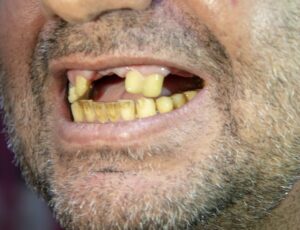
For instance, smokers have a greater risk of periodontal (gum) disease. The drying effect that smoking has on the soft tissues in the mouth offers an ideal breeding ground for oral bacteria. This enables easier entry of oral bacteria into the structures that support tooth roots.
According to the Centers for Disease Control & Prevention (CDC), a smoker has twice the risk for gum disease compared to that of a nonsmoker.
As oral bacteria thrive and reproduce in the mouth, gum tissues become tender and inflamed. These are signs of gingivitis, the beginning stage of gum disease.
Gum disease at this stage can cause persistent bad breath, swollen gums and gums that bleed easily when brushing. As it progresses, gum tissues turn red or purple from inflammation. Pus pockets may form at the base of some teeth. This advanced stage is known as periodontitis.
Eventually, the infectious bacteria penetrate below the gum line and attack supporting bone and the tissues surrounding tooth roots. This can cause teeth to loosen and eventually require removal. Gum disease is the nation’s leading cause of adult tooth loss.
Losing teeth is detrimental to your overall health and not a normal part of the aging process. Studies have shown that people who wear dentures die an average of ten years earlier than those who keep their natural teeth.
Denture wearers also have higher incidences of pneumonia, and worse. A 2015 report by NBC News shared findings surrounding dentures and MRSA biofilm. The report included a dental specialist’s warning that, “Concern about biofilms on dentures is growing as researchers continue to identify links between oral bacteria and heart disease, chronic obstructive pulmonary disease or COPD, and respiratory diseases, including aspiration pneumonia.”
Many smokers are aware that they have stained teeth and more-frequent bad breath than non-smokers. They also have slower healing periods after procedures such as extractions, gum treatment and oral surgery.
Although a hygienist may go slowly and gently, dental cleanings are typically less comfortable for smokers. This is because smoking causes a greater buildup of plaque. With gum tissues already tender from the bacterial irritation of plaque, removing buildup from between and around the base of teeth adds to the discomfort of inflamed tissues.
According to the American Dental Association (ADA), smoking increases the risks of oral cancer, lesions inside the mouth, enamel erosion and tooth loss in addition to periodontal (gum) disease.
If you vape, remember that nicotine in any form is a hazardous force in the mouth. And the vapor itself is not safe for oral health.
Vaping (using e-cigarettes) delivers nicotine through an inhaled mist. Although the vapor is generally not labeled as “dangerous,” one study of some e-cigarette products found the vapor contains known carcinogens and toxic chemicals, including, propylene or polyethylene glycol, glycerin, and additives. And, its nicotine is no less harmful to the user as that delivered via cigarette smoke.
Unfortunately, many cigarette users switch to vaping based on the perception that “e-cigs” are a safer alternative. For those hoping to wean themselves off cigarettes through this switch, very few achieve that goal as a result.
A 2018 report by the National Academy of Sciences, Engineering, and Medicine concluded there was “evidence that e-cigarette use increases the frequency and intensity of cigarette smoking in the future.”
Although the focus in this article is meant to be on oral health, allow me to reiterate some of the benefits of “kicking the habit” …
• Smokers have a decreased life expectancy of an average of 10–15 years compared to non-smokers.
• Smoking is linked to nearly a third of all cancer diseases and deaths.
• Pregnant women who smoke have a higher risk for first-trimester spontaneous abortion, preterm births, low birth weight babies and sudden infant death syndrome (SIDS).
• Women who smoke are at risk for early menopause while men who smoke are more at risk for impotency.
• People who breathe in your “second hand” smoke (what you exhale) are subjected to over 50 known carcinogens and other harmful chemicals.
For those who are able to give up smoking, the effort is well worth it. The positive effects can be felt almost immediately. In about 48 hours, damaged nerve endings begin to restore. The sense of smell and taste begin to return to normal.
“Quitters” also notice their breathing is easier in about 3 days and they have fuller air intake. Oral health improves within 2 weeks as blood circulation in the gums and teeth returns to nearly that of non-smokers. Heart attack risk also declines with blood flow greatly improving. Activities are easier and the constant smokers cough is gone.
 In our Asheville periodontal office, our goal – for every patient – is to help each achieve optimal oral health and a smile he or she is proud to share. For those who smoke, we make individualized recommendations so the potential for achieving this is favorable.
In our Asheville periodontal office, our goal – for every patient – is to help each achieve optimal oral health and a smile he or she is proud to share. For those who smoke, we make individualized recommendations so the potential for achieving this is favorable.
If tooth loss has already occurred, we are specialists in the treatment of all stages of gum disease and in the diagnosis and placement of dental implants. We will be happy to discuss the dental implant system that may be best for your needs.
Or, if dental fear or anxiety have kept you from receiving regular dental care, ask us about oral or IV sedation (“twilight sleep”). These sedatives are delivered by an MD of anesthesia for your optimal safety and comfort. And, in all procedures, we make patient comfort a high priority.
Call 828-274-9440 to schedule an examination.
Sources:
https://www.cdc.gov/tobacco/campaign/tips/diseases/periodontal-gum-disease.html
https://www.sciencedaily.com/releases/2016/11/161116101821.htm
https://www.nbcnews.com/healthmain/dirty-dentures-dangerous-mrsa-may-be-lurking-dentists-say-662637
https://www.cdc.gov/tobacco/basic_information/e-cigarettes/index.htm
Oral Health & Tooth Loss Within America’s Aging Population
Posted on Sep 18, 2023 by William J. Claiborne, DDS MS
There are currently 54.1 million U.S. adults ages 65 and over; a number that is expected to grow to 95 million by 2060.
In 1900, the percentage of American adults over the age of 65 was just 4.1%. Today, that number has grown to nearly 16%. By 2040, the elderly adult population is estimated to be more than double the senior population of the year 2000.
https://www.aplaceformom.com/caregiver-resources/articles/elderly-nursing-home-population
Many baby boomers (Americans born between 1946 – 1964) will keep their teeth longer than any generation before, yet they continue to experience a preventable decline in oral health.
Common risk factors such as smoking, poor diet, a reduced capacity to care for one’s teeth and obtain professional dental care, and biological mechanisms – such as low salivary flow caused by medications – may contribute to tooth decay and tooth loss.
Periodontitis (advanced gum disease) is a prevalent oral disease in older adults. It is typically marked by inflammation of the gums and supporting structures of the teeth, resulting in sore and bleeding gums as well as painful chewing problems. Loss of the supporting structures of the teeth (including supportive bone) results from an imbalance of bacteria that exist in the space between the teeth and the gums. This leads to an inflammatory response that develops into periodontal disease.
As teeth lose support from their diseased foundation, mobility and tooth drifting can occur in addition to abscesses, which can ultimately result in tooth loss. As the disease intensifies, bone loss around affected teeth can advance with a worsening infection that can lead to serious health problems far beyond the mouth.
Periodontal disease is associated with chronic diseases such as cardiovascular disease, diabetes, respiratory disease, and dementia. Along with other challenges to maintaining good health, the prevalence of any periodontitis among older adults is high. Three in five older adults are affected, with prevalence higher in men and persons with low incomes. Four in five older adults who smoke cigarettes have some form of periodontitis.
The loss of all natural teeth, known as edentulism, reduces quality of life because it interferes with the ability to eat, speak, and feel comfortable among other people. Tooth loss also affects a person’s ability to consume nutritious food and can impact social involvement with others while consuming food.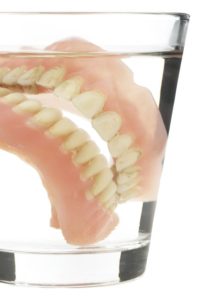
Overall, 17% of adults 65 and older are edentulous. Fortunately, edentulism has declined over the years among older adults aged 65 to 74, from about 50% in the 1960s to 13% today.
https://www.cdc.gov/oralhealth/pdfs_and_other_files/Oral-Health-Surveillance-Report-2019-h.pdf
Prevalence of total tooth loss among adults ages 65 and over is higher in both North and South Carolina than many other states, which is in the 16.6 – 26.3 percentage range. This compares to states like Illinois, Wisconsin and Utah, which are some states in the 6.2 – 11.3 percent range.
https://www.ncbi.nlm.nih.gov/books/NBK578296/figure/ch6.fig6/?report=objectonly
Having fewer than nine teeth is considered severe tooth loss and can cause major difficulties in eating a healthy diet of fresh and nutritious fruits, protein-rich meats and sufficient fiber. Without chewing comfort, strength and stability, food choices can result in either weight loss or obesity. Extensive tooth loss also detracts from physical appearance and impedes speech, another challenge to social contact and job prospects. This can also inhibit intimacy, lower self-esteem, and impact overall quality of life.
https://www.nidcr.nih.gov/sites/default/files/2017-10/hck1ocv.%40www.surgeon.fullrpt.pdf
Another challenge for older adults is orofacial pain. Orofacial pain in older adults can originate inside the mouth from tooth-related or gum infections. It may also originate outside the mouth, such as pain in the jaw joint area, or face and cheeks. Orofacial pain often results from ill-fitting dentures or a microbial infection causing an inflammatory reaction known as denture stomatitis (an oral yeast or fungus condition)
Older adults also struggle with “dry mouth.” Dry mouth is surprisingly common – an estimated 35 million U.S. adults may have this condition, known as xerostomia. Common causes include medications, autoimmune disease, systemic diseases, and as a result of head and neck irradiation.
Drugs are by far the most common risk factors for chronic dry mouth. Nearly 9 in 10 (89%) adults aged 65 and older take prescription medicine. More than half (54%) report taking four or more prescription drugs. The drugs most consistently implicated in “dry mouth” are antidepressants, diuretics, beta blockers, bronchodilators, and antihistamines.
High-risk behaviors are generally less common among older adults than in younger age groups. About 9% of those 65 years and older reported that they were current smokers, and 8% reported excessive alcohol consumption (having five or more drinks in one day at least once in the past year). Cannabis use also is on the rise among seniors although it remains less than 5%.
The problems associated with poor oral health and tooth loss extend greatly to other areas of the body. Oral bacteria and their toxins can spread into the bloodstream through ulcerated or inflamed tissues during chewing, routine oral hygiene, and dental procedures. In weakened gum tissues, even the act of tooth brushing can open up entry points for bacteria plaque and gingival inflammation in the bloodstream.
In addition, the presence of oral bacteria or their toxins may induce inflammatory responses, which can prompt insulin resistance. Oral bacteria can reach tissues in the lung, heart, gut, placenta, joints, and even the brain. They have been associated with infective endocarditis, and chronic inflammation may contribute to systemic conditions such as cardiovascular disease and diabetes.
Obviously, there are many causes for oral health challenges, all having a detrimental effect on quality of life to some extent. We want to help the residents of Western North Carolina enjoy their retirement years with a healthy, confident smile and oral health that supports good overall health.
First, know the signs and symptoms of periodontal (gum) disease, which include:
• Swollen or puffy gums
• Gums that turn red, dark red or dark purple gums
• Gums that are tender or bleed easily
• Seeing blood when brushing or flossing
• Persistent bad breath
• Pus pockets that form between teeth and gums
When periodontal disease exists, it is important to know that this will not go away without treatment. Once this infection is underway, it will only worsen, leading to more painful symptoms and even eventual tooth loss.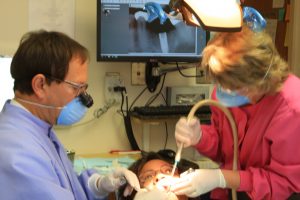
If you have signs of gum disease, see a periodontal specialist as soon as possible. In addition to lowering the risk of tooth loss, a periodontist can help you lower the risks of gum disease’s infectious bacteria in the bloodstream, which research has linked to serious (and even deadly) health problems.
Call our Asheville periodontal dental office to schedule a consultation. If fear or anxiety has prevented you from regular dental visits, we can discuss several options (including oral or IV sedation) to provide comfortable, relaxed appointments. Call 828-274-9440.
Recent Posts
Categories
Archives
- September 2024
- August 2024
- July 2024
- June 2024
- May 2024
- April 2024
- March 2024
- February 2024
- January 2024
- December 2023
- November 2023
- October 2023
- September 2023
- August 2023
- July 2023
- June 2023
- May 2023
- April 2023
- March 2023
- February 2023
- January 2023
- December 2022
- November 2022
- October 2022
- September 2022
- August 2022
- July 2022
- June 2022
- May 2022
- April 2022
- March 2022
- February 2022
- January 2022
- December 2021
- November 2021
- October 2021
- September 2021
- August 2021
- July 2021
- June 2021
- May 2021
- April 2021
- March 2021
- February 2021
- January 2021
- December 2020
- November 2020
- October 2020
- September 2020
- August 2020
- July 2020
- June 2020
- May 2020
- April 2020
- March 2020
- February 2020
- January 2020
- December 2019
- November 2019
- October 2019
- September 2019
- August 2019
- July 2019
- June 2019
- May 2019
- April 2019
- March 2019
- February 2019
- January 2019
- December 2018
- November 2018
- October 2018
- September 2018
- August 2018
- July 2018
- June 2018
- May 2018
- April 2018
- March 2018
- February 2018
- January 2018
- December 2017
- November 2017
- October 2017
- September 2017
- August 2017
- July 2017
- June 2017
- May 2017
- April 2017
- March 2017
- February 2017
- January 2017
- December 2016
- November 2016
- October 2016
- September 2016
- August 2016
- July 2016
- June 2016
- May 2016
- April 2016
- March 2016
- February 2016
- January 2016
- December 2015
- November 2015
- October 2015
- September 2015
- August 2015
- July 2015
- June 2015
- May 2015
- April 2015
- March 2015
- February 2015
- January 2015
- December 2014
- November 2014
- October 2014
- September 2014
- August 2014
- July 2014
- June 2014
- May 2014
- April 2014
- March 2014
- February 2014
- January 2014
- December 2013
- November 2013
- October 2013
- September 2013
- August 2013
- July 2013
- June 2013
- May 2013
- April 2013
- March 2013
- February 2013
- January 2013
- December 2012
- November 2012
- October 2012
- September 2012
- August 2012
- July 2012
- June 2012


